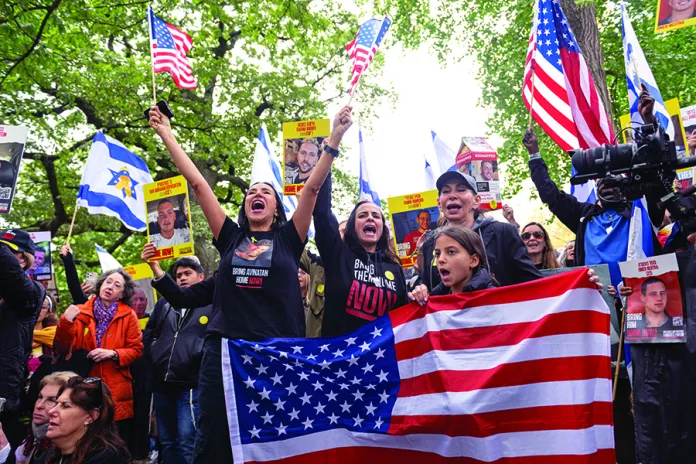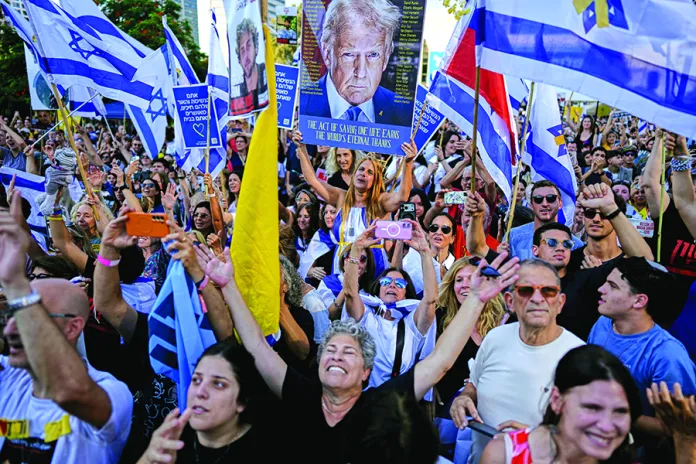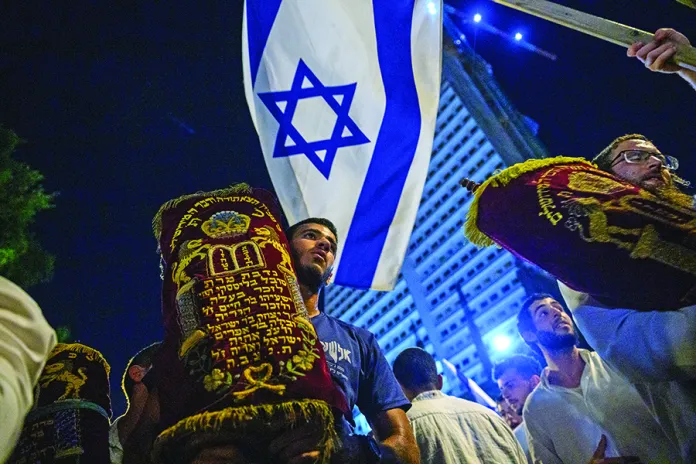Two years ago, on the joyous eve of Simchat Torah, the Hebrew calendar’s exuberant celebration marking the culmination of the annual Torah reading cycle, Hamas shattered the world for Jews everywhere. It was Oct. 7, 2023, a Saturday morning, when families in southern Israel should have been dancing with sacred scrolls under open skies and singing praises to the God who delivered His people from bondage. Instead, the air filled with the screams of the dying and the gunfire of terrorists who poured across the border like a plague from hell.
In a meticulously planned atrocity, the deadliest assault on Jews since the Holocaust, Hamas terrorists and their allies slaughtered 1,200 souls and abducted 251 more into the bowels of Gaza. They rampaged through kibbutzim such as Be’eri and Kfar Aza, gunning down grandmothers in their kitchens, hunting festivalgoers at the Nova music site where 364 young lives were extinguished in a frenzy of hate, and dragging people into vans bound for tunnels of torment. The victims weren’t soldiers or settlers in disputed lands. They were Jews at prayer, at play, at peace — targeted for the singular sin of existing as Jews.
This wasn’t collateral damage from a military operation. It was a 21st-century pogrom, in which the attackers filmed their depravities and broadcast them as trophies. Hamas’s charter calls for the extermination of Jews — their actions that Sabbath morning made it manifest. And as the world watched in horror, or, in too many corners, in calculated silence, the aftershocks rippled across oceans, landing hardest on American shores.

For Jews here in America, the images weren’t abstract geopolitics. They were visceral nightmares, stirring the ghosts of ancestors who fled Cossack swords and Nazi gas chambers. “It could have been us,” became a whispered refrain in synagogues from New York to Los Angeles, a dread that clawed at our collective subconscious. Why? Because the Oct. 7 massacre wasn’t confined to Israel’s borders. It weaponized an ancient vulnerability, reminding every Jew that hatred doesn’t need provocation — it needs only prey.
Consider the math of fear. In the two years since, antisemitic incidents in the United States have exploded, shattering records and exposing the fragility of our assimilation. The Anti-Defamation League tallied over 10,000 attacks from Oct. 7, 2023, to Sept. 24, 2025 — a 200% surge from the prior year, with bomb threats against Jewish institutions tripling and assaults on individuals quadrupling. Synagogues vandalized with swastikas, Jewish students harassed on Ivy League campuses, kosher markets firebombed — these weren’t anomalies but a tidal wave, often cloaked in “anti-Zionist” rhetoric that served as modern cover for age-old Jew-hatred.
A 2024 American Jewish Committee survey found that 9 in 10 American Jews believe antisemitism had spiked since the attacks, with 7 in 10 feeling less secure in their own country. Campuses, once bastions of free thought, became battlegrounds: Over 3,000 antisemitic incidents were logged at anti-Israel rallies alone, where chants of “From the river to the sea” morphed into explicit endorsements of Hamas and Hezbollah. In New York, a Jewish man was beaten on the subway for wearing a kippah. In California, highway overpasses bore banners from white supremacists echoing Hamas’s genocidal rhetoric. The FBI’s 2023 hate crime data confirmed that Jews, comprising just 2% of the population, faced 68% of religious-based attacks, a statistic that climbed in 2024 as the war dragged on.
This wasn’t mere backlash to Israel’s response — it was opportunism, a global green light for bigots who saw Jewish blood spilled in Gaza’s shadow as permission to spill it here. Protests that began as calls for cease-fires devolved into glorifications of the kidnappers, with effigies of bound hostages paraded as props. For American Jews, the hostages weren’t distant symbols — they were mirrors. Families such as the Zangaukers, torn apart when Matan was seized from Nir Oz alongside his partner Ilana, evoked our own kin: the relatives who survived Auschwitz, and the grandparents who witnessed Kristallnacht. Every video of emaciated captives — Evyatar David forced to dig his own grave in a Hamas propaganda clip, or Alon Ohel and Eliya Cohen handcuffed in tunnels while guards feasted — replayed like a collective PTSD.

In the now-infamous tunnels — Gaza’s subterranean labyrinth, a 60-foot-deep nightmare of 3-foot-wide tombs — hostages endured 738 days of isolation and torture. Released captives such as Tal Shoham described ceaseless digging by captors, with hammers echoing from dawn to midnight, while prisoners starved, chained in darkness without sunlight or human touch for months. Agam Berger, a 20-year-old IDF soldier, spoke of interrogations and abuse; Omer Shem Tov, kidnapped from the Nova festival, turned to the Psalms for solace, vowing to don tefillin daily if he survived. No water, scant food, psychological torment — these were conditions that conjured Sobibor or Treblinka, not 21st-century captivity. For eight months, some, including David, saw no daylight, their bodies wasting away like the living corpses in the concentration camps. It was captivity as cruelty, a slow erasure of the soul, and it haunted American Jews in our sleep. Like many, for these past two years, I’ve had nightmares about those tunnels, just like I had nightmares about the concentration camps when I was growing up, knowing that it easily could have been me in there — it could have been any of us. Because if any of us happened to have been in the wrong place at the wrong time — in southern Israel on Oct. 7, or in Europe in the 1940s — we would have suffered the same fate too, for the simple crime of having been born a Jew.
The agony compounded with each stalled negotiation. Under the Biden administration, talks mediated by Qatar and Egypt limped along, hampered by Hamas’s intransigence and Israel’s unyielding security demands. Despite U.S. pressure, no comprehensive deal materialized — Hamas rebuffed ceasefires, demanding full Israeli withdrawal without disarming, while Palestinian prisoner releases stalled over the Philadelphi corridor. Then-President Joe Biden’s team, including envoy Brett McGurk, cited Hamas’s bad faith, but critics pointed to a lack of leverage: no ironclad threats, no “peace through strength” that might force concessions. Eight months of ground operations in Gaza yielded rescues and strikes on Hamas leaders, but the hostages languished, their signs of life, such as videos of Hersh Goldberg-Polin pleading from underground hell, drip-fed as propaganda. American Jews watched, our hearts in vice grips, as holidays passed in shadow: Hanukkah without the Zangaukers whole, Passover seders with empty chairs.
Simchat Torah itself became a scar. The holiday, whose name means “Rejoicing with the Torah,” marks the Torah reading’s annual completion and restart — a cycle of renewal, celebrated with exuberant singing and dancing in every shul. But for two years, it arrived laced with grief. In 2023, as sirens wailed, families mourned amid the ruins. In 2024, vigils replaced dances, and posters of the missing fluttered like ghosts. American synagogues mirrored the pall: subdued hakafot, with prayers for the captives intermixed with the usual songs. The joy — the unbridled, childlike delight in God’s word — was stolen, replaced by a vigil that felt as if it would never end.

Then, like manna from heaven, came Oct. 13, 2025. President Donald Trump, back in the White House, did what years of diplomacy could not: He broke the impasse. Drawing on alliances forged in his first term, the Abraham Accords’ web of Arab states, Trump unveiled a 20-point Gaza peace plan. It was classic Trump: bold, unapologetic, and laced with the steel of consequences. Accept by Sunday, he warned on Truth Social, “or all HELL, like no one has ever seen before, will break out against Hamas.” Hamas blinked. On Oct. 3, its leaders agreed to release all hostages, living and dead, under the plan’s terms: phased exchanges for 1,968 Palestinian prisoners, Israeli withdrawal to agreed lines, and the resumption of full aid.
Israel’s Cabinet approved the first phase. Within 72 hours, as stipulated, the impossible unfolded. On the eve of Simchat Torah 5786, precisely two Hebrew years after the massacre, the last 20 living hostages emerged from Gaza’s maw. Red Cross vehicles ferried them across borders, and Israeli medics whisked them to hospitals in Petah Tikva and Re’im. Omri Miran, 48, abducted before his wife and two children at Nahal Oz, at long last stepped back into sunlight. Matan Zangauker, 25, reunited with his mother, Einav, after 738 days, his emaciated frame a testament to survival’s cost. David, the Nova festivalgoer whose grave-digging video horrified the world, waved weakly from an ambulance, his father Avishay noting the intentional starvation that stripped him to a walking skeleton.
In Tel Aviv’s Hostages Square, 65,000 people erupted in cheers as screens broadcast the reunions. Children with fathers, parents with sons — the raw footage showed tears and embraces. Trump, addressing the Knesset amid standing ovations, declared the war “over,” flanked by Netanyahu, who hailed him as “the greatest friend Israel has ever had in the White House.” From Sharm El Sheikh, Egypt, where the deal was inked, Trump marveled at the Arab world’s unity, forged by a strong hand — in stark contrast to Biden’s ineffectual softer touch.
For American Jews, the relief crashed like a dam breaking. Synagogues buzzed with calls of gratitude. Social media overflowed with videos of families toasting l’chaims in advance of the holiday. “A sigh of relief,” said Caren Leven, an Israeli American in Florida, her voice cracking on NTD News. The timing was divine poetry: the very date desecrated by slaughter now redeemed by release. Hakafot could once again ring out unmarred, Torah scrolls could circle again in joy, and we were able to dance once again on Simchat Torah without being shadowed by yellow ribbons or “Bring Them Home” banners. For the first time since 2023, the holiday’s essence —pure, unadulterated simcha — could reclaim its place.
This moment transcends borders — it’s a lifeline for the American Jewish soul. The past two years tested our resilience, forcing a reckoning with the ugly recrudescence of resurgent antisemitism. Assimilation’s promise rang hollow amid rising hate, yet it forged solidarity. Rallies swelled, federations raised millions, and voices such as mine amplified the cry: Never again means vigilance here, too. The hostages’ return isn’t just vindication for Trump; it’s proof that strength begets peace. Biden’s era yielded partial truces but no endgame — his reluctance to wield the full U.S. hammer let Hamas dangle captives as shields. Trump, unburdened by lectures on “proportionality,” rallied allies and issued ultimatums, turning the tide in weeks.
Gratitude surges toward this president and his team. Released hostage Eliya Cohen declared that “Trump is a hero.” Netanyahu’s and Cohen’s praise echoed what many American Jews now feel: A leader who brokered the Abraham Accords and who, with the help of Jared Kushner and Steve Witkoff, has now negotiated this miracle too. Polls already hint at shifts. A 2024 AJC survey showed Orthodox and younger Jews trending Republican, alienated by campus chaos and Democratic equivocation. This deal could accelerate that shift: more American Jews may yet find homes in the Trump coalition, drawn by his unyielding support for Jewish safety abroad and at home.
IN NEW SUPREME COURT TERM, RELIGIOUS LIBERTY AND ROBERTS LEGACY ON THE DOCKET
Yet, as Winston Churchill would say amid victory’s haze, this is not the end. It is not even the beginning of the end. But it is, perhaps, the end of the beginning. Hamas is still in power in Gaza, its tunnels remain a latent threat, and its genocidal ideology is still unextirpated. The plan’s second phase — disarmament, governance sans terrorism — looms, fraught with risk. Iran lurks, Hezbollah, though severely weakened, simmers, and Gaza’s reconstruction demands vigilance against a Hamas resurgence. For lasting peace, Israel must secure its borders, deradicalize Gazans’ education, and build alliances that choke extremism’s funds. American Jews, too, must combat domestic hate, bolster security, educate allies, and reject false equivalences that equate victims with villains.
Still, on this Simchat Torah, as the sun dipped and the scrolls unfurled, we exhaled. The long nightmare— tunnels of despair, headlines of horror, nights of what-ifs — faded to memory. Families lit candles, children twirled in circles, and the Torah’s words rang true: “Choose life, that you and your offspring may live.” For Omri, Matan, Evyatar, and the 20 who walked free, for the 1,200 whose blood cries from the earth, for us Jews in America who have been living in the terror’s shadow — we reclaimed our joy. Am Yisrael Chai.
Daniel Ross Goodman is a Washington Examiner contributing writer, the author of three books, and the Allen and Joan Bildner Visiting Scholar at Rutgers University.

